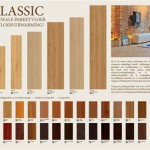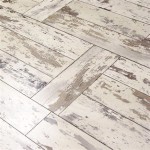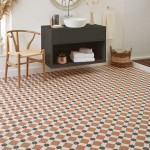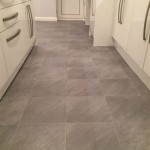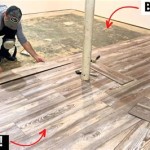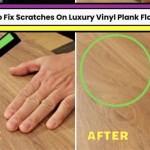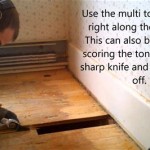Understanding Stick Down Flooring: A Comprehensive Guide to B & M Options
Stick down flooring, also known as self-adhesive or peel-and-stick flooring, has gained considerable popularity as a versatile and relatively easy-to-install flooring solution. The market offers a wide range of options, including those available from retailers like B & M. This article provides a detailed examination of stick down flooring, particularly focusing on B & M's offerings, covering aspects such as materials, installation, maintenance, and considerations for different applications.
Stick down flooring generally comprises a thin layer of vinyl, typically with an adhesive backing protected by a release paper. The installation process involves peeling off this paper and adhering the flooring directly to a prepared subfloor. This method contrasts with other flooring options like click-lock or tongue-and-groove systems, which rely on mechanical interlocks, or traditional glue-down methods that require a separate adhesive application.
B & M, a well-known discount retailer, offers a selection of stick down flooring options, often focusing on affordability and ease of use. These options typically include vinyl tiles and planks, with designs mimicking wood, stone, or other popular flooring materials. The specific selection and availability may vary by location and time, reflecting B & M's dynamic inventory management.
Types of Stick Down Flooring Available at B & M
The range of stick down flooring available at B & M typically includes various vinyl options. Vinyl is a popular choice due to its water resistance, durability, and affordability. Within the vinyl category, there are different types and constructions, each with its own advantages and disadvantages. Understanding these differences is crucial for making an informed purchasing decision.
One common type is standard vinyl tile and plank flooring. These are generally thinner and more flexible than more expensive alternatives. While affordable, they may be more susceptible to indentations from heavy furniture or damage from sharp objects. They are, however, suitable for low-traffic areas or temporary flooring solutions. B & M often features these as a quick and inexpensive way to update a room's appearance.
Another option, sometimes available, is thicker, more rigid vinyl. These offer better durability and a more realistic appearance, often mimicking the texture and feel of wood or stone. These planks and tiles are usually more resistant to wear and tear and can withstand higher traffic levels. However, they will typically be more expensive than the thinner options.
The aesthetic variations within stick down flooring at B & M are also considerable. There are typically wood-look planks in a range of finishes, from light oak to dark walnut. Stone-look tiles might mimic slate, marble, or granite. The availability of different patterns and colours allows for design flexibility to suit various interior styles. It's important to note that the quality of the printed design layer can vary, impacting the realism and overall aesthetic appeal of the flooring.
Installation Considerations for B & M Stick Down Flooring
The ease of installation is a major selling point of stick down flooring. However, proper preparation is essential for a successful and long-lasting result. The key to a professional-looking installation lies in meticulous subfloor preparation.
The subfloor must be clean, dry, level, and free of debris. Any existing flooring must be removed, and the subfloor should be thoroughly swept and vacuumed. Unevenness in the subfloor can telegraph through the thin vinyl, creating an unsightly appearance and potentially compromising the adhesive bond. Therefore, any cracks, holes, or irregularities must be filled and leveled using a suitable patching compound.
Moisture is a significant enemy of stick down flooring. Excessive moisture can weaken the adhesive and cause the flooring to lift or bubble. Before installation, the subfloor's moisture content should be checked using a moisture meter. If the moisture level is too high, it must be addressed before proceeding. This may involve identifying and fixing the source of the moisture or using a moisture barrier underlayment.
Acclimatizing the flooring to the room's temperature and humidity for at least 48 hours before installation is also crucial. This allows the material to expand or contract, reducing the risk of gaps or buckling after installation. During the installation process, it is important to carefully align the tiles or planks and press them firmly onto the subfloor to ensure a strong adhesive bond. Using a roller can help to distribute pressure evenly and remove any air bubbles.
While stick down flooring is generally considered a DIY-friendly option, complex layouts or challenging subfloor conditions may require professional installation. If you are unsure about your ability to properly prepare the subfloor or install the flooring correctly, it is best to consult with a qualified flooring installer.
Maintenance and Longevity of Stick Down Flooring from B & M
Proper maintenance is essential for extending the life and preserving the appearance of stick down flooring. While vinyl is generally durable and water-resistant, it is not impervious to damage. Regular cleaning and preventative measures are necessary to keep the flooring looking its best.
Regular sweeping or vacuuming is essential to remove dirt and debris that can scratch or dull the surface of the flooring. A damp mop with a mild detergent can be used to clean the flooring as needed. Harsh chemicals or abrasive cleaners should be avoided, as they can damage the vinyl and fade the printed design layer. It is crucial to always follow the manufacturer's recommendations for cleaning products and procedures.
Protecting the flooring from scratches and indentations is also important. Using furniture pads under the legs of chairs and tables can help to prevent scratches. Heavy furniture should be moved carefully, and protective mats should be placed in high-traffic areas. While the flooring is water-resistant, it is essential to clean up spills promptly to prevent staining or damage to the adhesive. Prolonged exposure to standing water can eventually weaken the adhesive bond.
The lifespan of stick down flooring from B & M will depend on several factors, including the quality of the flooring, the amount of traffic, and the level of maintenance. Thinner, less expensive options may only last a few years, while thicker, more durable options can last longer with proper care. If the flooring is properly installed and maintained, and is used in a low-traffic area, it can provide a cost-effective and attractive flooring solution for several years. However, it is important to be realistic about the expected lifespan and to be prepared to replace the flooring when it begins to show signs of wear and tear.
In conclusion, stick down flooring from B & M offers an affordable and relatively easy way to update the look of a room. By carefully considering the types of flooring available, properly preparing the subfloor, and following proper maintenance procedures, consumers can maximize the lifespan and appearance of their stick down flooring investment. While these options may not offer the same level of durability as higher-end flooring solutions, they can provide a practical and cost-effective alternative for certain applications.

Self Adhesive Wood Effect Floor Planks Grey Tiling Flooring

Self Adhesive Floor Tiles Grey Stone Effect Tiling Flooring B M

Self Adhesive Floor Tiles Grey Stone Effect Tiling Flooring B M

Kingmann Self Adhesive Rustic Wood Effect Vinyl Planks Flooring B M S

White Marble Effect Vinyl Tiles 6pk 60 X 30cm Diy Flooring B M

Self Adhesive Floor Tiles Slate Effect Tiling Flooring

Kingmann Self Adhesive Wood Effect Vinyl Planks White Flooring B M S

Sandstone Effect Vinyl Tiles 6pk 60 X 30cm Diy Flooring B M

Kingmann Self Adhesive Dark Oak Vinyl Planks Flooring B M S

Vinyl Flooring And Floor Tiles The 8 Pros Cons
Related Posts

